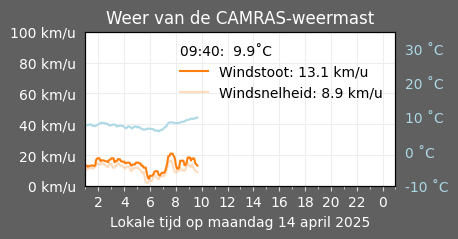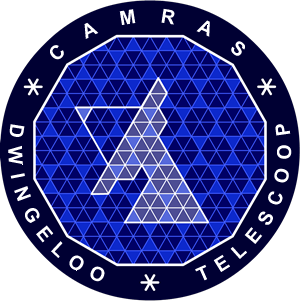Observing meteors with radio
Meteors cannot only be observed in visible light, but also with radio. If you are tuning a radio set to a special radio beacon, you can detect meteors both during the day and at night and during cloudy weather. And with a simple radio receiver, this form of radio astronomy is within reach for everyone.
Radio waves, just like visible light, are part of the electromagnetic spectrum. But where the visible light of a meteor cannot shine through a cloud cover, or is obscured in daylight, the radiowaves have no trouble detecting these meteors. Because of this you have the advantage that you can observe the so-called daylight swarms in addition to the usual meteor showers. These are meteoric swarms whose radiants only rise above the horizon during the day. How you can get started with this observation technique, we explain below.
Radar
You are probably familiar with RADAR or RAdio Detection And Ranging. This system works by means of a series of pulses of radio waves which, for example, collide with an airplane and reflect. The receiver listens, in the intervening periods that the transmitter does not transmit, to the echoes returned. This commonly used principle is called ‘back scatter’ radar and is used at airports and on board aircraft and ships. Another type of radar, the so-called ‘forward scatter’ radar, works with an arrangement in which the radio source is continuously transmitting and the receiver is set up at a further remote location. The great advantage of this technique is that the sky is constantly ‘illuminated’ and reflections are also possible over longer distances. After all, there is no need to take into account the pulse duration and interval frequency, and the traveling time of the echo. All objects flying through the radio beam are irradiated and reflected so that you do not suffer from the false and double echoes and other artifacts that occur with a back scatter radar.
Meteors and the reflection of radio signals
The principle of detecting meteors with the help of a ‘forward scatter’ radar is clarified in the illustration below. Through the curvature of the earth the beacon appears below the horizon and therefore it can not be received directly. The moment a meteoroid enters the atmosphere at very high speed, it collides with the nitrogen and oxygen molecules present there. Due to the shock wave and friction the atoms of air molecules become ionized, that is to say electrons are released from their orbit around the nucleus of the atom. They form a kind of cloud with free electrons (-) and cations (+), which hangs around the meteoroid as a cloud(creating the ‘head echo’) and leaves an ionized trace behind the meteoroid. If the ion density is large enough, this creates a plasma cloud that forms a good reflector for radio waves; the so-called ‘overdense’ reflections arise in this way. In this way the radio signal reflecting from both the ‘head echo cloud’ and the ionized trail can reach the observer whilst otherwise it is inaudible.

Illustration: Workgroup Meteors (KNVWS). Geometry of radio reflections on meteors. The ionized trace reflects the radio waves just as visible light reflects on a mirror. In this way, a connection is made between the radio source and the receiver through the intervention of the meteor.
When the ion density is too low, only partial reflection of the radio signal occurs, resulting in much shorter and weaker ‘underdense’ reflections. These types of reflections can be heard via the radio receiver as ‘pings’ and ‘bursts’, which are respectively the expression forms of the mentioned reflections on underdense and overdense meteor tracks. The duration of these reflections varies between a fraction of a second to sometimes several seconds. Moreover, due to the high speed of the ionized ‘cloud'(forming the ‘head echo’), a Doppler shift also occurs in the received transmission frequency, which is noticeable because the ‘pitch’ of the radio signal changes rapidly. The remaining ‘overdense’ iononized plasma cloud creates a pitch which changes only within several Hz close to the transmitter frequency and has very little Doppler shift.
Special meteor beacons
A few years ago it was quite possible to observe ‘meteor scatter’ with the aid of the image carrier of analogue TV stations that were broadcast in the VHF band (30 to 300 MHz). These TV stations were spread across Europe and usually had a large signal strength. Unfortunately, these analogue stations disappear due to the emergence of digital DVBT transmitters that broadcast on the UHF band (300 to 3000 MHz), a frequency band that is usually unsuitable for meteor scatter and narrowband doppler measurements on meteor reflections. Nevertheless, the low VHF band remains the most suitable for observing meteor scatter.
The Belgian Institute for Space Aeronomy (BISA) has set up a special meteor beacon in Belgium as part of their ‘BRAMS’ project. This beacon broadcasts at 49.970 MHz and is located in the south of the Ardennes at the ‘Centre de Physique du Globe’ in Dourbes (see the photo below). There is however a second VVS beacon situated in West Flanders with Astrolab IRIS in Ypres that broadcasts on the 49,990 MHz frequency. These beacons transmit with a modest power of 150 watts and 50 watts respectively. Their transmission frequency is just under a conventional amateur band and they can therefore be received with regular 6m antennas in combination with a cheap RTL-SDR dongle (a USB receiver). The reflections can be heard throughout the Netherlands and Belgium provided that the radio noise, the so-called ‘man made noise’, in the observer’s environment is not too high as a result of all kinds of devices. Some meteor observers in France, Germany and the South East of the UK have also been able to detect these Belgian meteor beacons. For others living afar we advise to use the frequency of the more powerful GRAVES radar(see description below).

Photo: CAMRAS (Frans de Jong) BRAMS meteor beacon. Radio Amateur Simon Bijlsma (PA7SB) at the special meteor beacon in the south of the Ardennes at the Center de Physique du Globe in Dourbes.
In 2005 the French Air Force has built a ‘foreward scatter’ radar intended to track satellites, rockets and space debris. The radar ‘Grand Réseau Adapté à la Veille Spatiale’ (GRAVES) transmits with a very high power at a frequency just below the 2-meter amateur band (143.050 MHz). It is known that the reflections of this radar can even be received over a distance of more than 1200 km. This makes it possible to easily receive the radio signal from the French space radar in the Netherlands with a directional antenna and an RTL-SDR dongle. Since meteors also briefly move through the beam of the radar and are unintentionally irradiated, it is possible to detect these echoes (reflections) of meteors.
The BRAMS and GRAVES radio sources are for the Belgians and Dutch the most suitable meteor beacons that can be used to receive the ‘meteor scatter’ echoes when they have a suitable radio set-up. People living afar or in a ‘radio noisy’ urban environment are advised to solely use the GRAVES radar.
Detecting Meteors with an RTL-SDR dongle
The name has already been mentioned a few times, “RTL-SDR dongle”. This USB stick-like receiver is a so-called Software Defined Radio (SDR). It is a broadband radio receiver that can be operated via a laptop or PC and can be tuned to the desired frequency. They are easily available under the name of ‘DVBT / DAB sticks’. The days when you could only observe meteors with large, complex radio receivers and antennas seem to be a thing of the past (but you can of course still observe meteors with that setup!). The affordable dongles make meteor observation with radio particularly accessible because everyone has a laptop or computer and can get started with this interesting form of meteor observation. Read what you need to detect meteors with a RTL-SDR dongle.
Build an optimized directional antenna yourself
Just as a camera needs a suitable lens to capture meteors, a radio receiver needs an antenna. Although you can also buy the right antenna, it is much more fun (and affordable) to build your own antenna that is optimized for the frequencies of the GRAVES radar or the BRAMS meteor beacons. View the list of materials and the building instructions for making a Yagi antenna.
Self-built 3-element Yagi antennas for meteor observations. With the building descriptions on this website you can make one of these antennas yourself.

Photos: CAMRAS (Simon Bijlsma) On the left the antenna optimized for GRAVES (143 MHz) and on the right for BRAMS (49 MHz).
Text contribution: Simon Bijlsma (PA7SB), radio amateur, amateur astronomer and volunteer at CAMRAS, the C.A. Muller Radio Astronomy Station.

